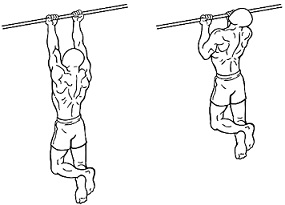Pull-up progression

Pull-up is a great exercise, but for a lot of people, and especially women, it can be hard to do. In this article, I will give you a pull-up progression template that will make you do 10 strict pull-ups no matter your current level.
Starting out right and progressing correctly are the major factors to achieve any fitness goal. Therefore, the pull-up progression template will have different starting points and then a realistic progression path.
Before we jump in to the pull-up progression plan, let’s take a look at how pull-up is preformed, some of its relatives and which muscles it works.
A regular pull-up is performed by gripping a bar with your palms facing away from yourself, and the distance between your hands a bit wider than your shoulders. From this position, the lats should be activated by pulling the shoulder blades down.
Holding this grip your elbows should be pointing more to the sides than in front of you, but not completely to the sides. Elbows pointing forward will address more muscles in the arm than elbows pointing to the sides, which will address the lats.
For the body position, there are two options.
The gymnastic hollow hold comes to mind but is also the preferred one. 
In this position the complete core will have to work as well. Therefore, you will get a more complete workout with this position.
The bent leg and arched version is easier and often the preferred by many.
No matter which position you select, your body needs to be engaged and not just in a dead hang position. An engaged body is stronger than a relaxed one. This means that it will be easier to perform your pull-ups.
Now with the combined efforts of arms, shoulders, and lats, you simply pull yourself to a position where the chin is just over the bar. It is important to focus on squeezing your shoulder blades together as you rise up during the pull-up.
Different versions:
The pull-up has a close relative called chin-up. The difference is the grip. Here, your palms face you. In this version, the biceps are a big contributor and therefore often easier for males with natural big biceps.
Different grips and body positions can be added to the standard pull-up in order to vary the muscle activation. We will use some of them for the pull-up progression.
In the chest to bar version, we pull until the chest touches the bar. In the bar muscle pull-ups, we pull ourself over the bar and extend our arms.
A regular pull-up, as described above, will mostly work the lats and the arms. However, the biggest benefits are the focus on the lats as well as other parts of the upper back.
Often, our upper back muscles are weak and stiff to do the massive time we spend with our arms in front of our body either using a keyboard, mobile phone, or driving etc.

Progression template:
Ok, now that we know what a pull-up is, how we do it and which muscles it’s working, let’s have a look at the different levels of the pull-up progression template.
-
Level 1: You cannot do a pull-up and you cannot hang in your arms for 20sec
-
Level 2: You cannot do a pull-up, but you can hang in your arms for longer than 20sec
-
Level 3: You can do 1-2 pull-ups
-
Level 4: You can do 5 pull-ups
The equipment we need for our pull-up progression is limited to a pull-up bar and maybe some sort of pull-up grips if you have sensitive hands.
Now find your level and see how to perform each exercise in the video below.
Level 1:
Goal: We want you to be able to gain enough grip strength so you can hang in your arms for a minimum of 20sec
Preparation: Test for how many seconds you can hang in your arms.
Session 1:
5 rounds of:
5 dead hangs for 60% of you max dead hang time (If you can hang max 10sec, then do 5 times of 6sec).
Make sure to rest 30sec between each repletion and 1:30 min between each round.
Session 2:
3 rounds of:
3 dead hangs for 80% of your max dead hang.
Make sure to rest 45sec between each repletion and 1:30 min between each round.
Session 3:
3 rounds of:
1 max dead hang – Simply hang as long as possible – note the best try and use that for next week.
Rest 2 min between each round.
Session 4:
5 rounds of:
3-5 scapular pull-ups (See video demo for Scapular pull-up)
Rest 1min between each round
Level 2:
Goal: We want you to be able to do our first pull-up
Preparation: Test if you can do a pull-up every 3 weeks
Session 1:
5 rounds of:
5-8 scapular pull-ups (See video demo for Scapular pull-up)
Rest 1min between each round
Session 2:
5 rounds of:
3-5 negative pull-ups (Jump to top position and lower yourself as slow as possible. If possible rest 1-2sec in the top position).
Rest 1:30min between each round.
Session 3:
5 rounds of:
5 horizontal pull ups (Select a version that is challenging and proceed to the next level when you master it).
Rest 1:30 min between each round
Session 4:
5 rounds of:
5 supported pull-ups. (Use either a rubberband or a chair to support you.)
Rest 1:30 min between each round.
Level 3:
Goal: We want you to be able to gain enough strength so you can do more than 5 pull-ups
Preparation: Test how many pull-ups you can do every 3 weeks.
Session 1:
5 rounds of:
8-10 scapular pull-ups (See video demo for Scapular pull-up).
Rest 1min between each round
Session 2:
5 rounds of:
5-7 negative pull-ups. (Jump to top position and lower yourself as slow as possible. If possible rest 1-2sec in the top position.)
Rest 1:30min between each round.
Session 3:
5 rounds of:
8 horizontal pull-ups (Select a version that is challenging and proceed to the next level when you master it.)
Rest 1:30 min between each round
Session 4:
5 rounds of:
1 pull-up with max pause when you rise to the top. (If it becomes too difficult, jump to top and hold for as long as possible.)
Rest 1:30min after each round.
Level 4:
Goal: We want you to be able to gain enough strength so you can do more than 10 pull-ups
Preparation: Test how many pull-ups you can do every 3 weeks
Session 1:
5 rounds of:
10-12 scapular pull-ups. (See video demo for Scapular pull-up)
Rest 1min between each round
Session 2:
5 rounds of:
8 negative pull-ups. (Jump to top position and lower yourself as slow as possible)
Rest 1:30min between each round.
Session 3:
5 rounds of:
1-2 chest to bar pull-up
Rest 1min between each round.
Session 4:
5 rounds of:
1 pull-up with max pause when you rise to the top. (If it becomes too difficult, jump to the top and hold for as long as possible.)
Rest 1:30min after each round.
Remember to be patient with the progression. Follow above template and you will succeed. If you are looking for a more complete bodyweight workout routine please find it here.

